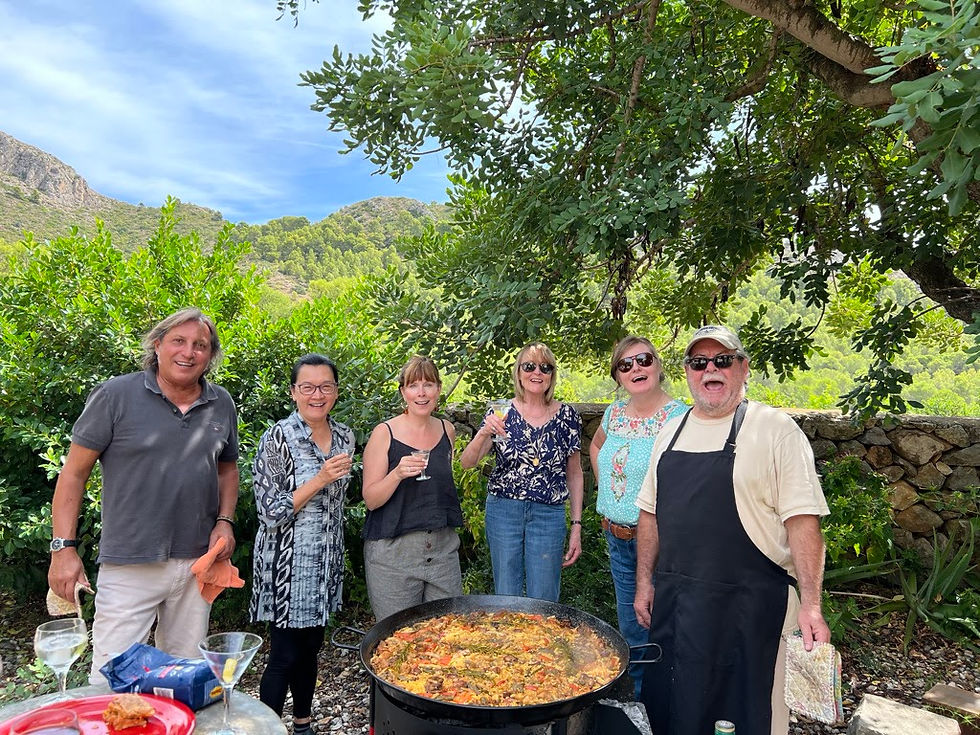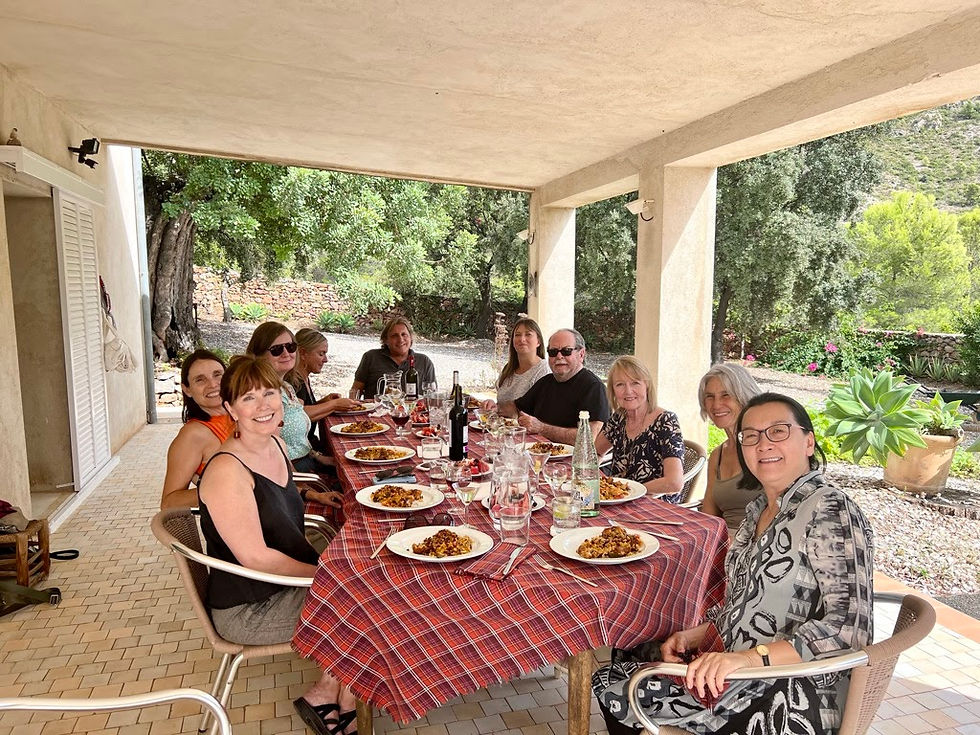Authentic Valencian Paella: tradition, facts and recipe
- Small Wonders Travel
- Nov 19, 2023
- 5 min read
Updated: Jan 18, 2024
One of the most beloved experiences from our tours, and what was the original "center point" from which our "Spanish Wonders and Culinary Delights" trip was created, is the day Paco prepares Paella for our travelers.

Paella, even though it's one of the most famous Spanish dishes, it’s not a traditional meal in all of Spain. It belongs to the region of Valencia, where it originated, and Valencians are very protective of their traditional Paella, how to cook it, how to eat it and especially about what ingredients are and aren’t acceptable in an authentic Valencian Paella.
Here are some facts about Paella that might surprise you:
First of all, the real Valencian Paella does not include seafood.
The Paella originated in the fields -inland, not by the coast- where the farmers would use what was available for them to cook lunch while they worked the land. Chicken, vegetables like tomato and some local beans, rabbit, maybe duck or even snails, and of course the local variety of rice arroz bomba. But not fish. Valencia is known for its rice, which is cultivated in the Albufera. There are many traditional rice dishes, some of them include seafood, but they are not called Paella. When Valencians talk about Paella, it’s the one with meat and veggies. If they are talking about a rice dish with fish, they will say “Fish Paella” or call it by its specific name like “Arroz a banda”, “Arroz negro” or “Arroz del senyoret”, even these are all cooked in the same kind of paella pan.

The name Paella comes from the dish it is cooked in.
Paella is the name of the pan used to cook it. It’s a flat, shallow pan with a handle on both sides. Traditionally, paella is not served on plates, but eaten directly from the pan (also with a set of non-written rules like “no eating from your neighbor’s portion”)
Paella should be cooked on an open fire.
Not only that, but the wood should be from orange trees, which gives it an even more distinctive local flavor.

You want your Paella to burn a little on the bottom.
This is called “socarrat” in Valencian language, it’s the bottom layer of rice -not really burnt but toasted, crispy and almost caramelized. The sound the spoon makes against the pan when you scratch it to get some of the socarrat on your plate, is music for every Valencian.
Paella is a lunch dish.
Paella is considered to be too heavy to eat for dinner, especially since in Spain dinner is usually eaten at 10pm! That’s why Paella is always eaten at lunch. Only tourists will eat paella for dinner!

Sundays (and Thursdays) are Paella Day.
Most Valencian families still get together on Sundays to eat Paella. But most restaurants will also have paella as part of their lunch menu on Thursdays. Even schools serve paella for lunch on Thursdays. The reason is that, traditionally, Thursday was when the house servants would have their day off; they would leave the paella almost ready the previous day, so the lady of the house only had to add the rice for the meal to be ready. It’s also said that many families would go out to eat at restaurants on that day, where they would then be served Paella.
Paella is not only a meal, but a social event
When you get invited to a Paella, you are there also during the process of making the paella. There are snacks and drinks served as "aperitivo" and social conversation. Everyone participates; some prepare the meat, some cut the veggies, some help with the fire, some set the table and some are in charge of the snacks and drinks for the aperitivo. There is only one "paella master": is the one cooking and deciding how it's cooked. No matter how many opinions and comments are made (and there are always many!) the master has the last word.

If you are invited to a Paella, expect it to last a few hours.
As we said, you arrive at least one hour before the paella is ready, then you eat, and then you stay for another while for the so-called "sobremesa" which can last 1, 2 or even 6 hours!
Sobremesa literally translates to "over the table", and it's the Spanish custom of sitting and relaxing around the table after a meal. Coffee and liquor, maybe some sweets, are usually served. But mostly is about chatting and hanging out.. Sobremesa deserves its own entry, so we will tell you all about this Spanish tradition in a completely different post!

Every region, town or even family, has its own way of preparing Paella. We are going to share with you Paco’s recipe -from the notes Li-li, one of our travelers, took while paying close attention as it was being made:
Paella For 10-12 people
1 kg pork ribs
1/4 duck
1/2 chicken
1 rabbit
Salt
3 tsp of sweet paprika powder
2 Saffron packages (about 8g)
Olive oil
1/2 Kg Green beans
1/4 Kg Garrofons (a local bean from Valencia, similar to lima or butter beans)
1/4 Kg Snow peas (optional)
10 Artichokes (if in season) pealed and cut in quarters. As you prepare them in advance, after cutting them place them in a bowl with water and parsley to avoid oxidation.
1/2 Red capsicum cut in 3cm pieces
4 Garlic cloves chopped
800 g tomatoes grated
80-100g of Bomba rice per person (1.2Kg)
Five times the volume of the rice of water (1 part of rice = 5 parts of water)
Pour some olive oil into the paella pan
Add the meat and cook until roast on the outside (in the following order and waiting a few minutes before adding the next one: duck, pork, chicken and then the rabbit, as for some meats it takes longer than for others).
Add the artichokes, if you are using some. Cook for a bit and add the green beans and capsicum.
Add the chopped garlic and when it's cooked, pour in the grated tomato.
Stir and mix well.
Wait a few minutes until the tomato is done, and then add the water and the Garrofon beans.
Bring to boil.
Add sweet paprika and salt.
Take a little bit of the broth into a small bowl and stir in the saffron until mixed and pour back into paella.
Simmer until the liquid it's reduce to half (it will take about 30min).
Taste the broth and add more salt if necessary (it should be on the salty side as the rice will absorb most of the flavor).
Add the Bomba rice and spread it evenly across the pan. After that, you shouldn't stir it again.
Bring it to the boil on high heat for 5min, then reduce the heat, add the snow peas and let it all cook evenly -without stirring- for about 15min. After a few minutes, add a few sprigs of rosemary on top for extra flavor.
If you pay attention, towards the end, you'll hear the change in the sound it makes, from bubbling rice to burning/toasted bottom.
Cook no more than 20 minutes total.
Remove. Rest 10 minutes. Serve.

Take a look at our Spanish Wonders and Culinary Delights tour!



Such a great explanation! Thank you!